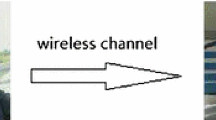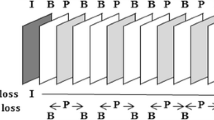Abstract
The H.264/AVC standard introduces enhanced error robustness capabilities enabling resilient and reliable transmission of compressed video signals over wireless lossy packet networks. Those robustness capabilities are achieved by integrating some new error resilience tools that are essential for a proper delivery of real-time video services. Those tools include the Intra Refreshing (IR), Arbitrary Slice Ordering (ASO), Sequence Picture Parameter Sets (PPS), Redundant Slices (RS) tools and Flexible Macroblock Ordering (FMO). This paper presents an error resilient algorithm in wireless H.264/AVC streaming. The proposed method merges Reference Frame Selection (RFS), Intra Redundancy Slice and Adaptive Intra Refreshment techniques in order to prevent temporal error propagation in error-phone wireless video streaming. The coding standards only specify the decoding process and the bitstream syntax to allow considerable flexibility for the designers to optimize the encoder for coding performance improvement and complexity reduction. Performance evaluations demonstrate that the proposed encoding algorithm outperforms the conventional H.264/AVC standard. Both subjective and objective visual quality comparative study has been also carried out in order to validate the proposed approach. The proposed method can be used and integrated into H264/AVC without violating the standard.
Similar content being viewed by others
References
Psannis, K., & Ishibashi, Y. (2008). Efficient flexible macroblock ordering technique. IEICE Transactions on Communications, E91-B(08), 2692–2701.
Psannis, K., Hadjinicolaou, M. G., & Krikelis, A. (2006). MPEG-2 streaming of full interactive content. IEEE Transactions on Circuits and Systems for Video Technology, 16(2), 280–285.
Psannis, K., Ishibashi, Y., & Hadjinicolaou, M. G. (2007). QoS for wireless interactive multimedia streaming. In Proceedings of the 3rd ACM workshop on QoS and security for wireless and mobile networks 2007, Chania, Crete Island, Greece (pp. 168–171) October 22–24, 2007.
Psannis, K., Hadjinicolaou, M., & Ishibashi, Y. (2006). Efficient support of wireless video multicast services in 3G and beyond, advances in computer, information, and systems sciences, and engineering. In K. Elleithy, T. Sobh, A. Mahmood, M. Iskander & M. Karim (Eds.), Springer signals and communications, ISBN-13: 978-1-4020-5260-6 (pp. 121–127). Berlin: Springer.
Advanced Video Coding for Generic Audiovisual Services (2007). ITU-T Rec. H.264 and ISO/IEC 14496-10 (MPEG-4 AVC), ITU-T and ISO/IEC JTC 1, Version 1: May 2003, Version 2: May 2004, Version 3: Mar. 2005, Version 4: Sept. 2005, Version 5 and Version 6: June 2006, Version 7: Apr. 2007, Version 8 (including SVC extension): Consented in July 2007.
Floyd, S., Handley, M., Padhye, J., & Widmer, J. (2000). Equation-based congestion control for unicast applications. In Proc. ACM SIGCOMM, Stockholm, Sweden (pp. 43–56) Aug. 2000.
Floyd, S., & Fall, K. (1999). Promoting the use of end-to-end congestion control in the Internet. IEEE/ACM Transactions on Networking, 7(4), 458–472.
Chen, M., & Zakhor, A. (2006). Multiple TFRC connections based rate control for wireless networks. IEEE Transactions on Multimedia, 8(5), 1045–1062.
Song, H., & Jay Kuo, C.-C. (2004). A region-based H. 263+ codec and its rate control for low VBR video. IEEE Transactions Multimedia, 6(3), 489–500.
Lin, C.-H., & Wu, J.-L. (1997). Content-based rate control scheme for very low bit-rate video coding. IEEE Transactions Consumer Electronics, 43(2), 123–133.
Aramvith, S., Kortrakulkij, H., Tancharoen, D., & Jitapankul, S. (2002). Joing source-channel coding using simplified block-based segmentation and content-based rate-control for wireless video transport. In Proc. int. conf. information technology: coding and computing (ITCC) 2002, Las Vegas (pp. 71–76) Apr. 2002.
Lin, C.-W., Chang, Y.-J., & Chen, Y.-C. (2003). A low-complexity face-assisted coding scheme for low-bit-rate video telephony. IEICE Transactions on Information and Systems, E86-D(1), 101–108.
Sun, Y., Ahmad, I., Li, D., & Zhang, Y.-Q. (2006). Region-based rate control and bit allocation for wireless video transmission. IEEE Transactions on Multimedia, 8(1), 1–10.
Melo, C. A. V., & Fonseca, N. L. S. (2004). An envelope process s for multi-fractal traffic modeling. In Proc. IEEE int. conf. communication (ICC) 2004 (Vol. 4, pp. 2168–2173) June 20–24, 2004.
Erramilli, A., Narayan, O., Neidhardt, A., & Saniee, I. (2001). Multi-scaling models of TCP/IP and sub-frame VBR video traffic. Journal of Communications and Networks, 3(4), 383–395.
Kang, S. H., & Zakhor, A. (2005). Effective bandwidth based scheduling for streaming multimedia. IEEE Transactions on Multimedia, 7(6), 1139–1148.
Kwon, S.-K., Tamhankar, A., & Rao, K. R. (2006). Overview of H.264/MPEG-4 part 10. Elsevier Journal of Visual Communication and Image Representation, 17(2), 186–216.
Lambert, P., De Neve, W., Dhondt, Y., & Van de Walle, R. (2006). Flexible macroblock ordering in H.264/AVC. Elsevier Journal of Visual Communication and Image Representation, 17(2), 358–375.
Calafate, C. M., & Malumbres, M. P. (2003). Testing the H.264 error-resilience on wireless ad-hoc networks. Paper presented at the EURASIP video/image processing and multimedia communications conference, 2003.
Kim, M., Lee, S.-W., & Kim, S.-D. (2005). Error resilient texture coding scheme for wireless video transmission based on coefficient sampling and interleaving. SPIE Optical Engineering, 44.
Katz, B., Greenberg, S., Yarkoni, N., Blaunstien, N., & Giladi, R. (2007). New error-resilient scheme based on FMO and dynamic redundant slices allocation for wireless video transmission. IEEE Transactions on Broadcasting, 53(1), 308–329.
Ogunfunmi, T., & Huang, W. C. (2005). A new flexible macro block ordering with 3D MBAmap for H.264/AVC. In IEEE ISCAS 2005.
Rane, S., & Girod, B. (2005). Systematic lossy error protection of video based on H.264/AVC redundant slices. In Proc. visual communication and image processing VCIP-2006, San Jose, CA, Jan. 2005.
Wang, Y.-K., Hannuksela, M. M., & Gabbouj, M. (2003). Error resilient video coding using unequally protected key pictures. In Proc. international workshop VLBV03, Sep. 2003.
Baccichet, P., Rane, S., & Girod, B. (2006). Systematic lossy error protection based on H.264/AVC redundant slices and flexible macroblock ordering. In Proc. 15th international packet videoworkshop, Hangzhou, P.R. China, Apr. 2006.
Liu, H., Zhang, W., & Yang, X. (2006). Error-resilience packet scheduling for low bit-rate video streaming over wireless channels. In IEEE international symposium on circuits and systems, 2006.
Koumaras, H., Kourtis, A., Lin, C.-H., & Shieh, C.-K. (2007). A theoretical framework for end-to-end video quality prediction of MPEG-based sequences. In The third inter. conf. on networking and services—ICNS07, Athens, Greece, June 19–25, 2007.
Ziviani, A., Wolfinger, B. E., de Rezende, J. F., Carlos, O., Duarte, M. B., & Fdida, S. (2005). Joint adoption of QoS schemes for MPEG streams. In Multimedia tools and applications, April, 2005.
Liang, Y. J., Apostolopoulos, J. G., & Girod, B. (2003). Analysis of packet loss for compressed video: does burst-length matter? In IEEE international conference on acoustics, speech, and signal processing (pp. 684–687) 2003.
Apostolopoulos, J. G. (2001). Reliable video communication over lossy packet networks using multiple state encoding and path diversity. In VCIP (pp. 392–409). Bellingham: SPIE Press.
Hu, J., Choudhury, S., & Gibson, J. D. (2007). H.264 Video over 802.11a WLANs with multipath fading: parameter interplay and delivered quality. In IEEE international conference on multimedia and expo (pp. 1790–1793) 2007.
Guha, R. K., & Sarkar, S. (2006). Characterizing temporal SNR variation in 802.11 networks. In IEEE wireless communications and networking conference (Vol. 3, pp. 1408–1413) 2006.
Koumaras, H., Kourtis, A., & Martakos, D. (2005). Evaluation of video quality based on objectively estimated metric. Journal of Communications and Networking, 7(3), 235–242.
Koumaras, H., Kourtis, A., Martakos, D., & Lauterjung, J. (2007). Quantified PQoS assessment based on fast estimation of the spatial and temporal activity level. Multimedia Tools and Applications, 34(3), 355–374.
Wang, Z., Bovik, A. C., Sheikh, H. R., & Simoncelli, E. P. (2004). Image quality assessment: From error visibility to structural similarity. IEEE Transactions on Image Processing, 13(4), 600–612.
H.264/AVC Software Coordination (2009). Software version: JM 13.0. http://iphome.hhi.de/suehring/tml/.
Author information
Authors and Affiliations
Corresponding author
Rights and permissions
About this article
Cite this article
Psannis, K.E., Ishibashi, Y. Efficient error resilient algorithm for H.264/AVC: mobility management in wireless video streaming. Telecommun Syst 41, 65–76 (2009). https://doi.org/10.1007/s11235-009-9151-3
Published:
Issue Date:
DOI: https://doi.org/10.1007/s11235-009-9151-3




